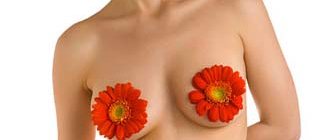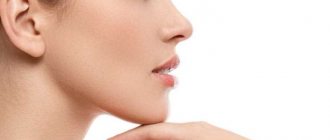It is difficult to underestimate the aesthetic role of the nipple. Their size and shape largely determine the sexuality and beauty of a woman's breasts. Deformation of the nipple, incorrect positioning of the nipple on the mammary gland, too large or too small nipples are a number of aesthetic problems that cause severe psychological discomfort in women. And, as a rule, a woman begins to think about correcting the defect with the help of plastic surgery.
Deviations in the structure of the breasts develop internal complexes in a woman, forcing her to hide her breasts, which affects her intimate life. One of the aesthetic defects is inverted nipples that do not protrude beyond the areola.
The problem of inverted nipples is quite common and affects one in ten women. The situation entails a number of both psychological and physiological inconveniences: complexes about aesthetics, fear of developing cancer, difficulty breastfeeding, etc.
Fortunately, inverted nipples can be treated quite successfully both conservatively (with early development of the pathology) and surgically. But let's talk about everything in order.
Thus, a woman with inverted nipples experiences difficulty breastfeeding, since it is extremely difficult for the baby to latch onto the breast and hold it while sucking milk. In all cases, an operation such as mammoplasty comes to the rescue.
An inverted nipple can also cause the development of inflammatory processes in the mammary gland, such as maceration (swelling) as a result of the accumulation of fat and foreign particles in the nipple cavity. In rare cases, an inverted nipple may be a symptom of more serious breast diseases (including cancer).
How to identify if you have inverted nipples?
First of all, it should be noted that inverted nipples can be either hidden or tightly inverted. In the first case, the nipple “appears” during sexual arousal, pressing on it, or during breastfeeding, in the second, it constantly remains under or at the same level with the areola (the area surrounding the nipple).
The presence or absence of inverted nipples can be determined at home. To do this, stand in front of the mirror, place your thumb and index finger on the areola (at a distance of about 2 cm from the nipple itself) and gently squeeze. The reaction of the nipple can indicate the degree of its retraction:
- First degree . Even slight pressure on the areola reveals the nipple. If you remove your fingers, the nipple maintains its position for a while and then slowly retracts back.
- Second degree . The nipple is pulled out when there is noticeable pressure. If you release the areola, it immediately returns to its original position.
- Third degree . An inverted nipple has no response to pressure. Breastfeeding is impossible in this case, but milk is released. The situation is aggravated by a predisposition to the development of various infections, inflammations and other complications.
It is worth noting that both nipples must be checked: the presence or degree of nipple retraction on different breasts may not be the same. However, in any case, you should contact a specialist at the first suspicion of retraction: this will avoid various complications and further progression of the disease.
Indications and contraindications
The final argument in favor of surgery is the inclusion of the diagnosis or symptoms of the applicant in the list of medical indications. It covers:
- loss of the nipple;
- loss of the entire areola, which occurs with a mastectomy;
- desire to change the current shape due to aesthetic unattractiveness;
- neutralization of defects or congenital deformities such as bifid nipple;
- breast lifting, which involves reducing the diameter of the areola.
At the same time, the doctor is obliged to check whether the patient has hidden contraindications. Some of them belong to the relative camp, which means a ban on performing the operation only temporarily.
Under more favorable circumstances, the contraindication is removed. Basic prohibitions include:
- pregnancy, lactation period;
- processes caused by infections;
- suspicions of oncological neoplasms of a benign and malignant nature;
- problems with normal blood clotting;
- predisposition to the formation of keloid-type scars.
Individual intolerance to the active ingredients of anesthesia and related medications is taken into account separately.
Why is the nipple retracted?
- genetic predisposition;
- pathology of the development of the genital organs (underdevelopment and hypofunction);
- insufficiency of development of the milk ducts;
- diseases of the mammary glands.
Acquired factors for the development of inverted nipples include:
- Complications of various diseases (infectious and inflammatory processes, oncology, etc.);
- Wearing a bra that is too tight and puts pressure on the mammary glands for a long time.
It is worth noting that if there are no visible causes for the development of inverted nipples, you should immediately consult a doctor. The same applies to the situation if, along with retraction, various types of liquid begin to be released from the nipples.
Causes of retracted papilla in teenage girls and women
Deviations in the structure of the nipple on the mammary glands in females can be caused by physiological or pathological factors:
| Natural Feature | Pathological deviations |
| Features of breast development (in adolescents). After the formation of the glands, the shape can take on a normal appearance. | Injury to the breasts, especially during their growth. And also poorly performed plastic surgery. |
| Congenital abnormalities in the formation of glands. | Incomplete development of ducts in the mammary glands. It may be a complication from serious illnesses suffered during the period of breast formation. |
| Predisposition at the genetic level (presence of inverted nipples in mother, grandmother, aunt). | Oncological or benign neoplasms in the mammary glands. |
| Tight bra or uncomfortable cups. | Inflammatory processes in the chest (mastitis). |
| Age-related breast sagging. | Tuberculosis of the mammary glands. |
| Rapid breast enlargement during pregnancy or puberty. | Dilation of the milk ducts. The pathology may be accompanied by shortening of the ducts with subsequent retraction of the nipple. |
| Long periods of breastfeeding. | Dermatological pathologies. |
The nipple (inverted) can be on one breast or on both. Physiological and pathological abnormalities are caused by changes in the length of the milk ducts (milk is released through them during feeding), which are connected to the nipple.
Conservative treatment of inverted nipples
Conservative treatment consists of both self-performed manipulations and the use of special medical devices.
For example, to correct the first degree of inverted nipples, you can try to use the Hoffman method. To do this, the thumbs must be placed on the base of the nipple opposite each other. Next, you need to gently pull the base of the nipple (areola) with your thumbs in opposite directions. The stretching must be repeated in all possible directions. The exercise should be started twice a day, gradually increasing approaches to five.
It is worth noting that oral and manual stimulation of the nipples during sex has a positive effect on the correction of inverted nipples. In addition, experts advise “twisting” the nipple between your fingers a couple of times a day.
To treat inverted nipples with specialized medical devices, among other things, a special vacuum attachment is used.
First of all, the nipple is lubricated with Vaseline. Next, the nozzle is applied to the chest, fixed with a surgical plaster, after which air is pumped out of it to create a vacuum. The device should be on the chest throughout the day, but is periodically removed to examine the condition of the skin (irritation or cracking is possible).
The duration of treatment is determined by the condition of both the nipple itself and the breast as a whole. Typically, treatment takes about 10-14 days.
Surgical treatment of inverted nipples
The surgical procedure depends on whether the patient plans to become pregnant in the future. If pregnancy is planned, the surgeon preserves the integrity of the milk ducts; if not, he dissects them. There is no big difference in the final results, but you should be aware that the preservation of the milk ducts can cause repeated nipple retraction (although the risk is still very small).
Regardless of whether the milk ducts are dissected, the operation can be performed either under local anesthesia or general anesthesia. To achieve better results and high aesthetics, the work is performed under a microscope.
Progress of the operation with preservation of the milk ducts:
- Anesthesia.
- Making incisions several mm long extending from the nipple.
- Release of the nipple and prolongation of the milk ducts.
- Creation of a triangular skin flap.
- Nipple pulling.
- Stitching.
The operation to correct the nipple while preserving the milk ducts lasts about 40 minutes.
Plastic surgery of inverted nipples with dissection of the milk ducts has a slightly different procedure:
- Anesthesia.
- Nipple incision.
- Dissection of the milk ducts.
- Stopping the bleeding.
- Applying internal sutures.
- Applying external sutures.
This operation lasts about an hour.
Diagnostics
A mammologist is involved in clarifying the nature of the pathology that causes nipple retraction. The following diagnostic measures are recommended:
- Questioning, external examination
. The doctor determines when nipple retraction appeared, what symptoms it was accompanied by, and how the disease developed. Examines and palpates the breast, assesses changes in the nipple and mammary gland, detects deformations, determines the presence, size and location of lumps, examines regional lymph nodes. - Ultrasonography.
It is more informative in young patients. Visualizes neoplasms, areas of necrosis, changes in organ structure. Allows you to assess the condition of the milk ducts. - Mammography.
Detects tumor nodes, subareolar microcalcifications, areas of fibrosis. Makes it possible to determine the thickness of the skin in the area of the nipple and areola. According to indications, it is supplemented with ductography and tomosynthesis. - Other imaging techniques
. MRI is used to detect preclinical changes. Scintigraphy is prescribed to confirm damage to the ducts in Paget's cancer, to clarify the size, nature, location and distribution of nodes in all forms of cancer. - Breast biopsy.
To collect material, a puncture, trephine biopsy or fine-needle biopsy is performed. The tissue sample is sent for histological or cytological examination. Similar tests are carried out after obtaining an impression smear from the nipple of the mammary gland. - Laboratory research
. They are used to identify tumor markers, determine the level of female sex hormones, and assess the general condition of the body.
Surgical correction of inverted nipple
Conservative treatment or surgery – which is better?
The treatment method depends entirely on the degree and cause of nipple retraction. If the degree is initial, you can try to correct the situation with a conservative approach. However, grades 2 and 3 retraction, in most cases, require surgical intervention.
It should be noted that the conservative method is not always completely effective and signs of inverted nipples (as well as complications) may reappear some time after treatment. Thus, the only radical way that will allow you to say goodbye to inverted nipples once and for all is surgical treatment.
Surgical approach
Due to the relatively low percentage chance of a successful outcome without recurrence, many patients choose surgery over alternative measures. This procedure is prescribed even to men, although they are extremely rarely treated with such a diagnosis.
Particularly difficult is reconstruction after a mastectomy, when it is necessary to create the nipple almost anew. This requires professionalism and specialist experience. A preliminary detailed consultation will be required to calculate the risks, as well as forecasts of success.
It is important to pay attention to the preliminary stage. The doctor is obliged to study the medical history in detail and also select the ideal anesthesia format. If necessary, an allergy test is performed at the preparatory stage to eliminate the risk of developing anaphylactic shock.
If we are talking about a minor intervention, then it is possible to use local anesthesia. But if the doctor has to work for a long time, restoring tissue at a deep level, then it is better to take advantage of general anesthesia. The patient will also need to undergo a laboratory blood test.
Postoperative period: what to expect and how to behave?
After the operation, bruising and swelling of the chest may be observed, which disappear without a trace within a couple of weeks. Thanks to small incisions and work under a microscope, the sutures heal quickly and there are practically no traces left of them.
For some time after surgery, a woman may notice a decrease in the sensitivity of the areolas and nipples, but within a few weeks the sensitivity returns.
The postoperative period requires avoiding visiting the solarium and sauna. If possible, you should avoid physical activity and stressful situations. In addition, it is recommended to walk more and breathe fresh air.
It is worth noting that prevention obliges the patient to visit a specialist at least once every six months, even if the operation is successful.
Breast ptosis - symptoms and treatment
The method for eliminating ptosis depends on its degree.
Grade I ptosis and pseudoptosis can be removed by installing implants. The skin will straighten, volume will be added, and the breasts will take their previous shape.
A small degree of ptosis can also be solved by endoscopic lifting, which is performed using small incisions in the armpit.
Ptosis of degrees II and III must be corrected by removing excess excess skin. This operation is performed using sutures. They come in three types: areola stitch, vertical stitch and anchor stitch. Which suture the doctor chooses depends on the individual characteristics of the patient. Moreover, if the patient does not have enough volume, it can be added by installing implants. Thus, two operations are performed at once: tightening and augmentation.[5]
The periareolar method of surgery (using a suture along the areola) leaves the least traces, but is used only for a small degree of ptosis. If the breasts are very sagging or there is asymmetry, this method of lifting will not be suitable.
The vertical lift method is desirable for patients with severe ptosis, as well as for those who need to add volume with an implant. However, in some cases, for example, when it is necessary to move the nipple, a vertical seam will not work.
The anchor method of lifting allows you to solve the widest range of problems:
- greater degree of ptosis;
- asymmetry of the mammary glands;
- displacement of areolas;
- insufficient or excessive volume;
- sagging of the lower part of the breast.
However, this method has the most pronounced seams.[6][7]
Ptosis is sometimes combined with breast hypertrophy, that is, with its too large size. This can be either a consequence of breastfeeding or the girl’s hormonal background. In this case, the plastic surgeon performs reduction mammoplasty, that is, it removes not only excess skin, but also reduces the size of the mammary gland.[8]
Postoperative complications
Complications after a breast lift are divided into natural and pathological.
Natural complications:
- Swelling after surgery. On average, they go away in 3-4 days, maximum in a week. In some cases, the surgeon prescribes additional medications to the patient that relieve inflammation and swelling.
- Chest pain. They may bother the patient for the first couple of weeks after surgery, so the doctor usually prescribes pain medication.
- Decreased breast sensitivity. This complication is also common in the postoperative period and goes away after a couple of weeks.
- Scarring. The first few months they are quite clearly visible. It is at this time that it is not recommended to be in the sun, as the seams may become pigmented. However, after a year they are completely healed. If necessary, they can be corrected later using a laser.
Pathological complications:
- Minor bruising and hematomas are normal after surgery. However, large hematomas can be dangerous and require surgical removal. Most often, they occur when the patient does not comply with postoperative recommendations, in particular, for the first time you cannot lie on your side and stomach.
- Seams coming apart. Normally, the suture heals within 7-10 days, after which a thin scar remains. However, if the edges do not adhere tightly to each other, suppuration may begin between them, or they may separate. This complication appears both due to insufficiently professional work of the doctor, and in connection with the individual characteristics of the body: impaired blood circulation and weakened immunity.
- A fistula is a hole that independently forms in the skin during a purulent process. It occurs when an infection occurs in the connective tissues of the breast during surgery.
- Bad result. The reason for this may be either the lack of professionalism of the plastic surgeon or the individual characteristics of the patient, which were revealed during the operation.
If after surgery the patient regains weight and then suddenly loses it, or gives birth to another child, a repeat operation may be required.
Complications arise in exceptional cases. Modern diagnostic methods make it possible to identify all the characteristics of the body even before surgery and correctly correct all the nuances. Moreover, modern types of anesthesia and surgical technologies have minimal impact on the patient's health. The most important thing is to choose a doctor who inspires trust.











